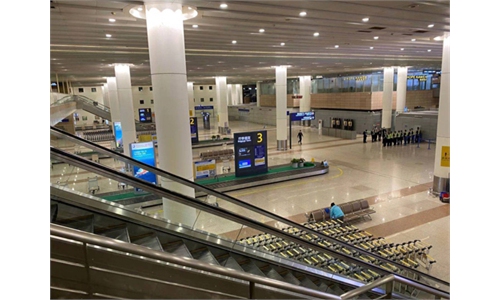Chinese passenger rail trips plunge over 70% in first 3 days of annual Spring Festival travel rush

A disinfection and temperature-checking robot checks the body temperature for a passenger in the waiting hall of the Shenyang North Railway Station in Shenyang, capital of northeast China's Liaoning Province, Jan. 28, 2021.Photo:Xinhua
China's passenger rail trips plummeted over 70 percent in the first three days of the annual Spring Festival travel rush, amid nationwide containment efforts to curb COVID-19 flare-ups, according to media reports on Sunday, citing data from China State Railway Group (China Railway).
Rail trips totaled 3.08 million on Thursday, the first day of the annual travel rush, 2.83 million on the second day and 2.96 million on the third day, the combined total equaling just one quarter of the levels seen last year, Chinese news site thepaper.cn reported on Sunday.
The number of trips is estimated to hit 2.9 million on Sunday, a freefall of 75 percent from the year before, according to the report.
During this year's Spring Festival travel rush, a duration of 40 days, beginning on Thursday, passenger trips across the country are estimated to amount to 407 million, or 10.18 million per day, Zhu Wenzhong, a deputy director from China Railway, said at a press conference in late December.
The prediction suggests an increase of 93.4 percent year-on-year, and is tantamount to the 2019 level, according to Zhu.
Nonetheless, as the country advocates a "stay-in-place" policy to avoid unnecessary flows of people during the forthcoming Spring Festival holidays, railway passenger trips see a substantial fall.
Despite this, railway departments have stood firm in implementing various virus prevention containment measures, per the Sunday report, citing preventive measures including body temperature detection for passengers, guides that encourage passengers to wear masks throughout their trips, and strengthened ventilation and disinfection at railway stations and in train compartments.
Contactless services are also being pushed to rein in the risks of spreading the disease, with the majority of travelers guided to use self-service turnstiles for entry, reduce movements inside the train carriages and scan QR codes to order food or opt for internet-based food delivery, among other distancing measures.
Global Times



